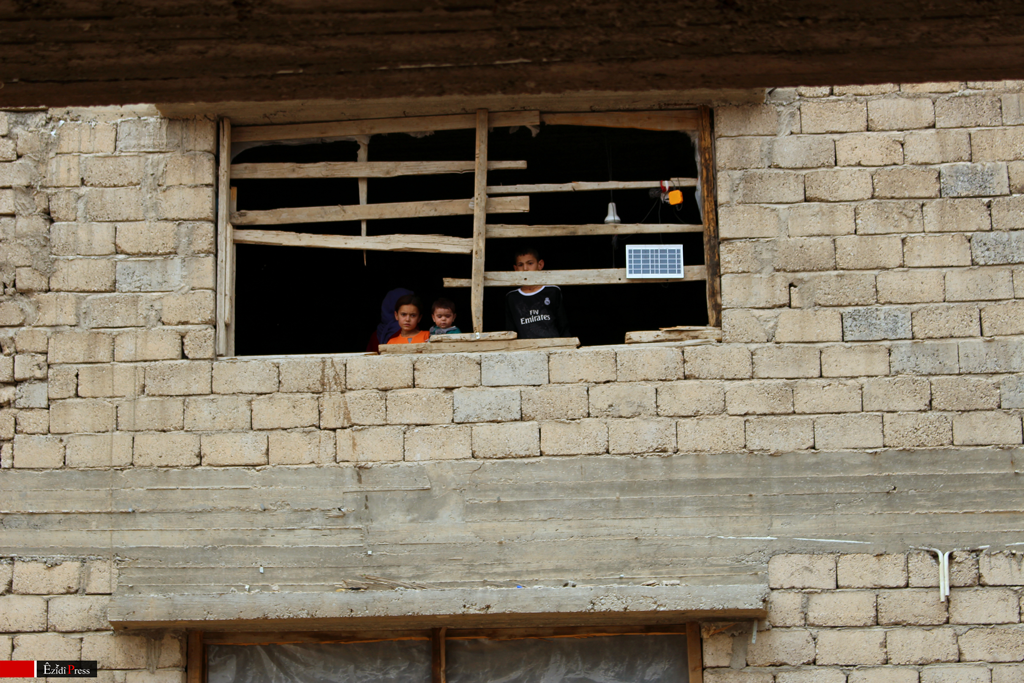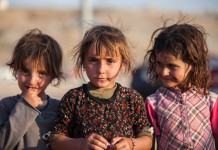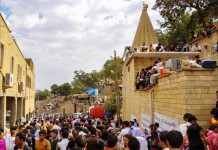
Translated by Thora Brudal from ÊzîdîPress German
Dohuk – “Up to this point,” says Hewas and shows with his right, outer edge of the hand on his left forearm. “Up to this point, to the bone. It’s enough, we are at the end,” he continues. The 26-year-old Yezidi stands in the refugee camp Esiya near the Kurdish city of Duhok, where approximately 18,000 Yezidis from Shingal have found refuge. He is surrounded by children with worn clothes, worn shoes, some of them barefoot.
Since the genocide by the terrorist militia “Islamic State” (IS) in August last year, which continues with the imprisonment of thousands of women and children, the Yezidi people is in a state of emergency. The terrorist militia hit in the midst of the heart of the Yezidi soul – Shingal, the main settlement area of the minority in northern Iraq. Defenseless civilians were overrun, massacred and kidnapped by the henchmen of the terrorist militia. The 8,000 Peshmergas in Shingal and another 3,000 stationed in the region fled even before the civilian population suspected that a genocide awaited them. When they woke up early in the morning, the Peshmerga had since long run away, and the black flag of the terrorists was approaching from three sides. Hundreds of thousands flee, tens of thousands looking for protection in the mountains, where they are eventually besieged for days and die of hunger and thirst. Everyone here speaks in whispers of treachery – even staunch supporters of the Kurdistan Democratic Party (Kurd. PDK) which is blamed for the disaster because they could have prevented it.
“They just took off. It was not in our will, certainly not. But it also does not change anything now. They did not only deliver our people to the Daesh terrorists [ISIS; note by the editor], but they also broke our pride,” says a senior Yezidi PDK functionary, who heads one of the major bureaus. He does not want to be named. Even non-Yezidi PDK officials in the round nod and follow the opinion, but nobody here dares to say it publicly. That would be tantamount to a defeat.

Hewas takes us from refugee camp to refugee camp, from Sharya through Esiya to Khanke, and back to Baadrê. To wild camps, passing outside the official camps, to unfinished buildings where several families are staying. “Not only have we lost our families, our entire livelihood is destroyed,” says a man who lives with three other families in Baadrê in one of these buildings. He has concreted the bottom of the shell himself. His 15-year-old niece was several months in captivity of the IS-terrorists, and was raped repeatedly. A little boy, about five, jostles from behind the grandmother. He, too, escaped along with his grandmother from the IS-captivity. His father was killed in Shingal, his mother captured. The uncle now bears all the burdens of the family.
We continue, in the official refugee camp of Sharya, going through the endless rows of tents. From terror to terror: Tent No. 1791, father and two sons killed; No. 1793, Mother in captivity, father and son killed; No. 1801, several daughters in captivity, one son killed; No. 1823, four orphans. Genocide.

Hewas himself is not from Shingal, but had to briefly flee when the terrorists also threatened to conquer his community Sheikhan near Duhok. And the frontline of Sheikhan can still be seen with the naked eye. Clouds of smoke over a village of the Shabak minority, in which the terrorist militia burns down everything. Nothing but scorched earth will remain, even after the defeat.

The strongly built young Hewas looks with a serious expression at us; whenever he sees what conditions the Yezidis, like all refugees have to live under. “Here we have no future, believe me. No matter what we do, this country is our grave,” he explains. Hewas’ family belongs to the middle class, unlike most refugees he will soon return, towards Europe. For a five-digit sum smugglers and tractors will smuggle him to Europe, he says. Not across the deadly Mediterranean, but over land. But for that you pay double the price for which the whole family has merged money.
Refugee camp in Baadrê. A few days earlier a mother of five managed to escape from captivity of the terrorist militia. Alone, her children are still in the captivity of the IS. Where they are being held captive, she does not know neither. Her husband was killed in the village of Til Ezer in Shingal. “I want nothing else but the return of my children,” she says. Has she heard about the program in Germany, we ask her. That traumatized women and girls are given psychological care in Baden-Württemberg, she can also register in the list. “Without my children?” she replies. “I’ll stay here and wait until they are back with me.”

The Yezidi community is practically leaderless during this difficult time. Also the highest representatives are powerless in the face of the enormous problems and challenges they face. They have no plan for the future, the society is probably more divided than ever. “All those who defend us, could promote and support us, want to emigrate. The weak and the poor are left behind,” laments a Yezidi Judge, who works in the Kurdish judiciary. He belongs to the upper class of the small Yezidi population who can buy a safe life. But no matter how qualified he is in his work, he will never be chief justice. For this he would have to take an oath on the Quran at inauguration. For Christians, Yezidis and other non-Muslim minorities unimaginable.
This could change by the new constitution, which is currently being drafted by a 21-member Commission for the Kurdish autonomous region. No Yezidis belong to the Commission, only after protests PDK made one of its seven seats vacant. Appointed was the retired Yezidi judge Nemir, who complained in a meeting with the religious Council of Yezidis in Lalish about discrimination. “They exclude me deliberately, turning their back on me and do not want that I participate” says Hakim Nemir. Again and again there have been verbal disputes within the Commission, always the Yezidi representative had to defend himself. “Without your support I will not be able to do anything,” he adresses the Yezidi representatives.

Whether in the Kurdish region or in the rest of Iraq. Hardly any Yezidis feel secure here. Despite of the for them sacred land on whose soil their sanctuaries are, the Lalish valley near Duhok or the carotid artery of the Yezidi history and culture, Shingal. For many it is certain that an abandonment of Shingal region heralds the end of Yezidism. Thousands of Yezidi fighters offer themselves daily in Shingal to prevent this. The severely traumatized war victims but only want to live in a safe country where they are not persecuted and massacred because of their religion. The terrorist militia has killed more than 5,000 Yezidis in Shingal, kidnapped up to 7,000. And much of the region is still under the authority of the self-proclaimed holy warriors.
The Yezidis were once a great nation, powerful, who ruled over large and influential principalities throughout the Middle East. Then forced conversions and extermination campaigns came. Nevertheless, one of the oldest religions could save itself up to the present time. The price for it: today the Yezidi community counts less than one million followers, spread over four continents worldwide.

In the collective memory of the Yezidis, all past massacres burn deep. In recent decades, however, they began to come to terms with their history and their traumas, to write down their religion and make it accessible to a broad public. Until they were shaken again by a massacre, the genocide in Shingal, which again throws back the community for years. Thousands of Yezidi women, children and girls were abducted, in the 21st century.
“For centuries, it has always been the same. Every fifty years a new massacre, it’s enough,” says Hewas who is already on the way to Europe. Just as hundreds of other Yezidis who every month try to escape from the battlefield in Iraq.
© ÊzîdîPress, June 24, 2015
























